Servicios Personalizados
Revista
Articulo
Indicadores
-
 Citado por SciELO
Citado por SciELO
Links relacionados
-
 Similares en
SciELO
Similares en
SciELO
Compartir
Epidemiologia e Serviços de Saúde
versión impresa ISSN 1679-4974versión On-line ISSN 2337-9622
Epidemiol. Serv. Saúde v.25 n.1 Brasília ene./mar. 2016
http://dx.doi.org/10.5123/S1679-49742016000100003
ORIGINAL ARTICLE
Evaluation of the completeness and timeliness of malaria reporting in the Brazilian Amazon, 2003-2012
Rui Moreira Braz1; Pedro Luiz Tauil2; Ana Carolina Faria e Silva Santelli3; Cor Jesus Fernandes Fontes4
1Secretaria de Vigilância em Saúde, Departamento de Vigilância de Doenças Transmissíveis, Brasília-DF, Brasil
2Universidade de Brasília, Faculdade de Medicina, Brasília-DF, Brasil
3Secretaria de Vigilância em Saúde, Coordenação-Geral do Programa Nacional de Controle da Malária, Brasília-DF, Brasil
4Universidade Federal de Mato Grosso, Departamento de Clínica Médica, Cuiabá-MT, Brasil
ABSTRACT
OBJECTIVE: to evaluate the completeness and timeliness of malaria case reporting, diagnosis and treatment in the Brazilian Amazon.
METHODS: this is a descriptive study using data from 23 fields of notification forms recorded on the Malaria Epidemiological Surveillance Information System (Sivep-Malaria) between 2003 and 2012.
RESULTS: data completeness was good in 86.0% of fields (≥90.0% filled in); there was timely recording of 40.6% of notifications at the Municipal Health Departments (0-7 days following notification) and 75.6% at the Ministry of Health (0-30 days following notification); timely diagnosis and timely treatment occurred in 44.6% and45.4% of patients, respectively.
CONCLUSION: most notification forms had good completeness; timeliness in recording notifications was below international standards; timeliness of diagnosis and treatment was below Health Ministry recommendations.
Key words: Malaria; Evaluation Studies; Epidemiological Surveillance; Disease Notification; Information Management.
Introduction
Completeness and timeliness are important attributes of a surveillance system in Public Health,1 keeping tight relation its performance.
Completeness refers to the amount of properly notified cases to health authorities,2 regarding the register of all variables provided in the notification form. Through this indicator, the quality of the data's collection of the disease under surveillance can be assessed.
Timeliness indicates the speed in getting the information to action and if it was timely provided to decision makers. Notification and investigation are fundamental as they allow people to know the magnitude of the disease and the appropriate adoption of preventive measures towards the monitoring and evaluation of control actions by the surveillance system.3 Considering that the main purpose of a surveillance system is to adopt timely actions in response to changes in the epidemiological structure of the disease, the timeliness becomes a key element to prevent the transmission spreadness.4
Some studies have analyzed the completeness and the timeliness of surveillance systems of specific events, such as tuberculosis,5 mortality rates due to suicide,6 declaration of live births and neonatal deaths,7 as well as groups of diseases present in the United States of America,8 especially in the state of Colorado-USA,9 and in Korea.10 Regarding malaria, a study conducted in Iran with the purpose of evaluating the timeliness of notifications in surveillance systems from the country is to be highlighted.11 In all these studies, the main tool used was the information system for cases notification.
The quality in information systems is absolutely necessary as they are important instruments to situational diagnosis: their data identify populations under risk, subsidize the planning and the decision making, suggest guidelines and specific action strategies to each population group,12 and also contribute to the practice of health based on evidences.13 Evaluating the quality of information is, therefore, essential to the health situation analysis.14
The Brazilian Malaria Control Program (PNCM) established, since 2003, the Malaria Epidemiological Surveillance Information System (Sivep-Malaria) as the main tool to monitor the disease. This system has enabled the control of malaria in the Brazilian Amazon, where there are more than 99% of malaria cases in the country. Studies over the functionality of Sivep-Malaria have already been performed;15 others used the system to analyze the transmission of the disease in women.16 However, Sivep-Malaria has not been evaluated regarding its own attributes as a surveillance system.
It is important to remember that in 2012 Brazil was responsible for 54% of the malaria registers in the Americas.17 The World Health Organization (WHO) has promoted efforts in the adoption of norms to eliminate and control the disease, based on evidences,18 in order to reduce the unacceptable burden of malaria and its economic and social impact in many countries.19 To reach these goals, the quality of information is vital and WHO has recommended the completeness and timeliness monitoring regarding the register of the diseases.20
The main goal of this study was to evaluate the completeness and timeliness of malaria case reporting, diagnosis and treatment in the Brazilian Amazon.
Methods
A descriptive study was held over notifications of malaria cases in the Brazilian Amazon, an endemic region for the disease, which contemplates nine states: Acre, Amapá, Amazonas, Pará, Rondônia, Roraima, Tocantins, Mato Grosso and Maranhão. Sivep-Malaria is the official notification system for notifying the disease in that region.
Completeness and timeliness were evaluated based on the cases registered on the national Sivep-Malaria between 2003 and 2012. Cases reporting are filled on a local level by hospitals, primary healthcare units and notification stations, called notifying units (NU) in this study The malaria cases are found through passive surveillance (when a patient goes to a NU to collect blood samples) or through active surveillance (when the health professional goes to the patient's residence to collect a blood sample). All diagnoses identify the species of Plasmodium (P. falciparum, P. vivax or P. malariae) and are confirmed through thick or thin blood smear, or rapid diagnostic tests. After being filled, notifications are sent to the Municipal Health Department (SMS) by the NU, where they are typed on the local Sivep-Malaria, or directly, on the internet at the national Sivep-Malaria, coordinated by the Ministry of Health (MS). Data typed in local Sivep-Malaria are recorded in an electronic archive and transmitted, also through internet, to national Sivep-Malaria. Immediately, data are available to simultaneous analysis by the notifying unit, by Municipal Health Departments, by State Health Departments and by the Ministry of Health (Figure 1).
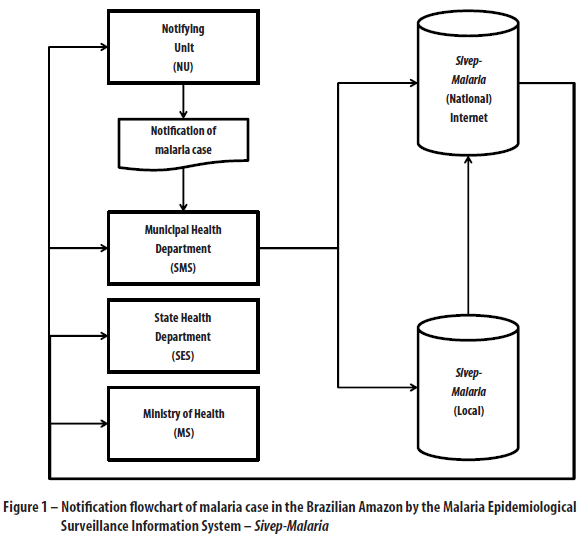
The Sivep-Malaria database counts with 43 fields. In the 2003-2010 period, the completeness of 21 of these fields was evaluated, and of 23 after 2011, when two new fields were introduced: data sending date to MS; and ethnicity/skin color. The following fields are considered strategic to PNCM:
- Notification date;
- Data sending date to MS;
- Typing date;
- Screening for recurrence;
- Code of the municipality of notification;
- Code of the municipality of residence;
- Locality code of residence;
- Patient's age;
- Patient's sex;
- Gestational situation;
- Education level; Symptoms;
- Date of the first symptoms;
- Occupation;
- Code of the municipalities of probable infection;
- Code of localities of probable infection;
- Examination date;
- Result of the positive examination;
- Parasitaemia in crosses;
- Initial date of treatment;
- Treatment scheme adopted;
- Ethnicity/skin color; and
- Active/passive surveillance case.
In this study, all new cases characterized by the presence of parasites or any of its components on blood, and detected by laboratorial examinations were included. Recurrences were also included, upon verification of the variable 'screening for recurrence' during and after recent treatment, in patients diagnosed with malaria that were treated to P. vivax in the previous 60 days of the current diagnosis or for P. falciparum during the previous 40 days of the current diagnosis.
To calculate the completeness of each field, the numerator was considered to be the amount of notifications where the field was properly filled , and the total amount of notifications evaluated was considered the denominator. Categories such as 'ignored' and 'others' were considered as unfilled fields and, therefore, eliminated from the numerator. The following parameters were used to measure the completeness quality: (i) good (≥ 90% of filling), (ii) regular (≥ 70% to <90%) and (iii) low (<70%). These parameters were adapted from an evaluative study of the completeness of the Information System for Notifiable Diseases (Sinan), 3where other diseases of compulsory notification are also registered. According to a pattern defined by the Ministry of Health,21,22 which provides the diagnosis and the initial date of treatment in up to 24 hours after the first symptoms, the timeliness of the diagnosis was measured by the time passed - in days -between the date of the first symptoms and the date of the diagnosis. Regarding the timeliness of the treatment, the time - in days - between the date of the first symptoms and the date of initial date of treatment was used. Both periods were classified into two categories: (i) timely (0-1 day) or (ii) late (≥ 2 days).
The timeliness in the availability of the notified cases reports to the health authorities was evaluated in two levels, adapted from WHO recommendations: 1,20
a) Level 1 - availability of reports to municipal authorities, meaning the time between the date of notification and the date of typing on local Sivep-Malaria, as (i) timely (0-7 days) or (ii) late (≥ 8 days); and
b) Level 2 - availability of reports to state and national authorities, meaning the time between the case notification date and the data registering date on national Sivep-Malaria, as (i) timely (0-30 days) or (ii) late (≥ 31 days).
The following were considered inconsistent/ignored and excluded from timeliness analysis: (i) time lesser than 0 (zero) days, (ii) time higher than 365 days and (iii) unfilled dates fields. To asymptomatic patients, the notifying date was used, when the date of the first symptoms was blank. Registers with inconsistencies related to the age of patients were not excluded.
To calculate the percentage of timely notifications, the amount of available notifications on municipal or national databases in timely terms was considered the numerator and the total of evaluated notifications in each level of the operation were considered the denominator.
National Sivep-Malaria data were provided by PNCM in 2013, with no identification of individuals, and tabled with the use of the Epi Info 2000 software, version 3.5.1. (Centers for Disease Control and Prevention, Atlanta-USA, 2008). In statistical analysis, a percentage was used to measure the completeness of the fields and to measure timeliness, the average of sent notifications, the median and the quartiles of sending dates were used.
This research was held exclusively with secondary data, with no identification of individuals. Therefore, the study project was dismissed from appreciation by the Committee of Ethics in Research, according to ethical considerations provided in the Resolution of the National Health Council (CNS) No. 466, dated December 12, 2012.
Results
In the period 2003-2012, 3,950,956 new malaria cases were notified. In the same time period the total amount of recurrences was 854,354. The higher number of new cases (606,020) was registered in 2005, and the lowest (241,665), in 2012. In the 2003-2010 period, 465 improbable registers regarding the age of patients - more than 120 years old - were registered.
In 2003, the 'date of typing' field presented only 34.2% of completeness, reaching good completeness in 2007 and staying on this level for almost all the time left - except in 2008, when its regular completeness was of 88.3%. The field 'ethnicity/skin color', although introduced in 2011, showed regular completeness of 87.6% already on its second year of register. The field 'occupation' had low completeness in all the period. Other fields had good completeness, equal or superior to 90.0% from 2010 on (Table 1).
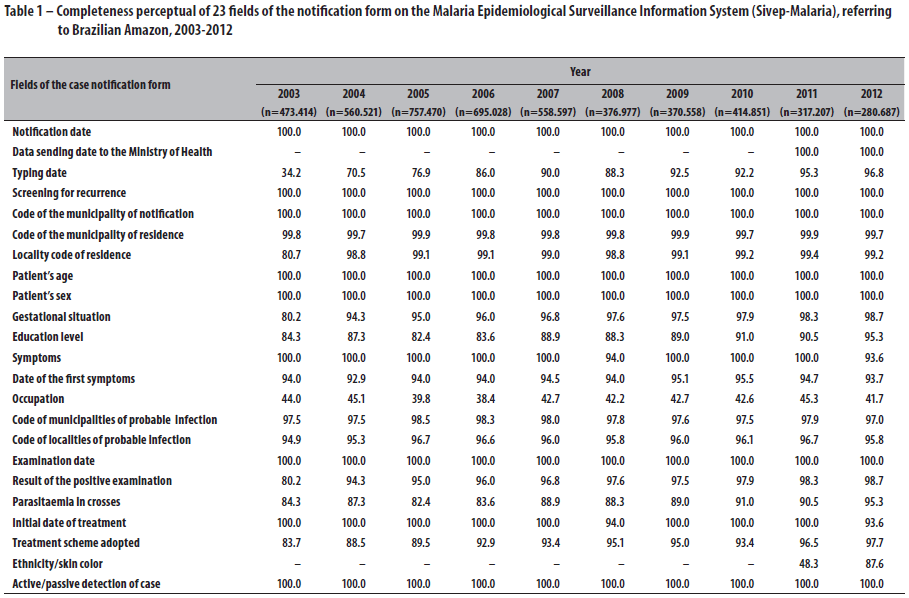
In 2003, 66.7% of the evaluated fields showed good completeness. This rate rose until 2007, when it peaked 90.5%, dropping in the following year; nonetheless, it reached 91.3% in 2012. Regular completeness varied from 23.8% in 2003 to 4.3°% in 2012. However, in 2010 and 2011, none of the fields registered regular completeness. There was little variation in the fields with low completeness; except in 2003 and 2011, when the highest rates were observed: 9.5% and 8.7% respectively (Figure 2). In the 2003-2012 period, 86.0% of the fields presented good completeness (≥90.0% of filling), 8.4°% regular completeness (≥70.0% and <90.0%) and only 5.6% of the fields presented low completeness (<70.0% of filling).
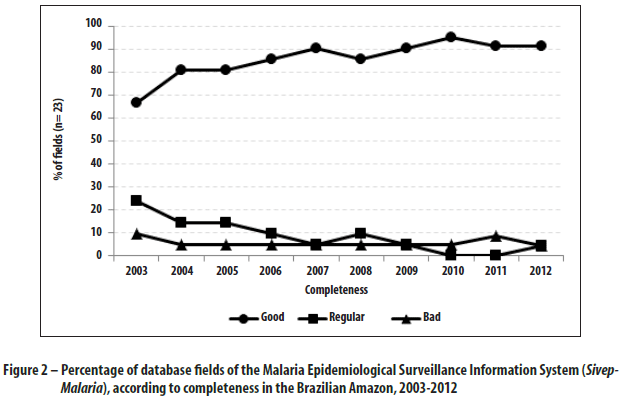
The diagnosis timeliness was verified in 4,783,094 notifications, representing 99.5% of new cases, plus recurrence in the period. There was little variation regarding timely diagnosis. In 2003, 41.5% of the patients were timely diagnosed, reaching 45.0% in 2012 (Table 2). Timely diagnosis happened in 44.6% of the total amount of notifications analyzed during the entire period. The median of diagnosis term was 2 days, in all years, with the first quartile of 1 day and the third quartile of 3 days.
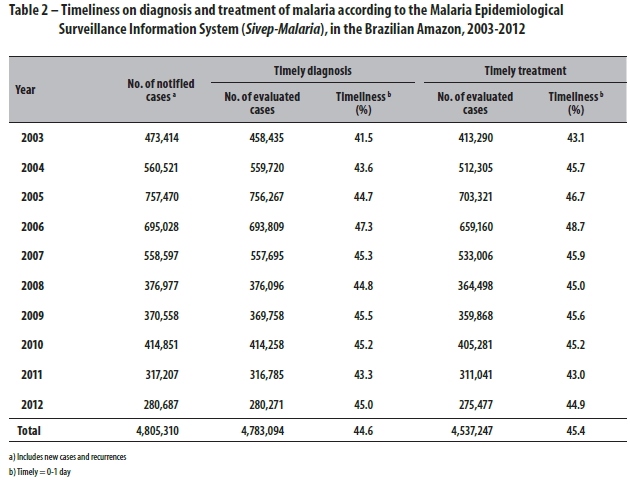
The state of Roraima registered the highest rates of timely diagnosis: 67.1% in 2010; falling to 43.0% in 2012. On the opposite direction, the state of Tocantins registered the lowest rates of timely diagnosis during the period, varying from 17.2% in 2005 to 9.0% in 2009 (Table 3).
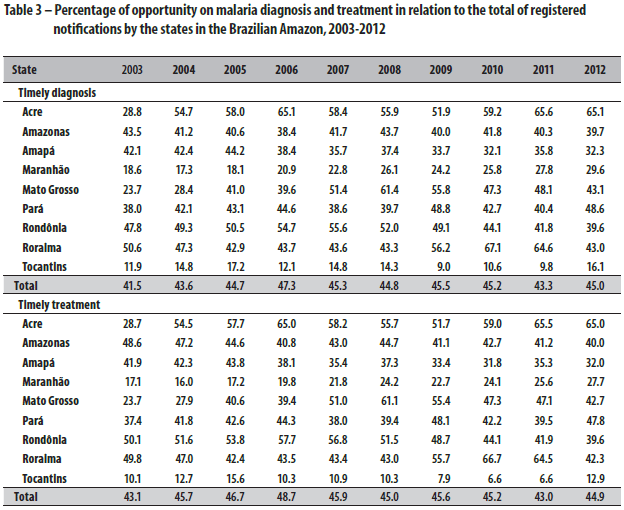
The treatment timeliness was evaluated in 4,537,247 notifications. The lowest rate of timely treated patients was 43.0% in 2011, reaching 48.7% in 2006 (Table 2). The average percentage of timely treated patients was 45.4% in the period. The time median of the treatment was 2 days and 75.0% of the patients were treated in up to 3 days, in all the years.
The state of Roraima showed the highest rate of timely treatment, corresponding to 66.7% of cases in 2010, decreasing to 42.3% in 2012. The state of Tocantins registered the lowest rates of timely treatments, reaching 6.6% in 2010 and 2011 (Table 3).
The timeliness in data sending by the NU to the Municipal Health Department (SMS) was evaluated in 3,863,380 notifications, corresponding to 80.4% of the total amount in the period. In 2003, only 21.7% of notifications were timely typed (0-7 days), reaching 54.1% in 2006; this proportion was reduced to 34.4% in 2011, increasing to 40.6% in 2012. The average of timely notifications sent by the NU to the SMS was 43.3% between 2003 and 2012. The median of data sending time to the SMS was 34 days in 2003, reaching 7 days in 2006 and 2007, and increasing to 10 days in 2012. In the beginning of the period, 75% of the cases, represented by the third quartile, were notified to the SMS in until 80 days, decreasing to 23 days in 2012 (Figure 3).
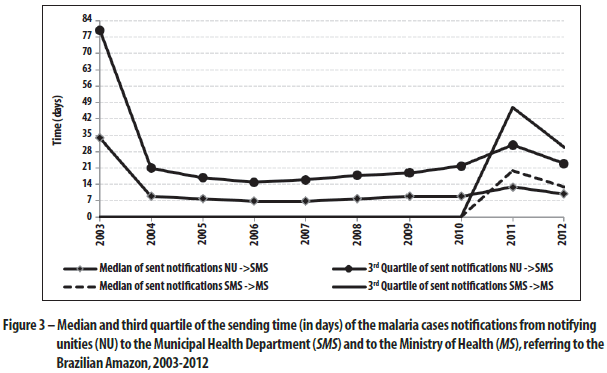
The state of Acre, in the last seven years of the evaluated period, showed the best rates of timely sending of data by NU to SMS, varying from 85.8% in 2006 to 77.2% in 2012. The states of Amapá, Maranhão, Mato Grosso, Pará, Roraima and Tocantins showed rates of timely sent data always inferior to 40.0% in the same period. The state of Roraima showed 16.9% in 2012, which was the worst result of the year (Table 4).
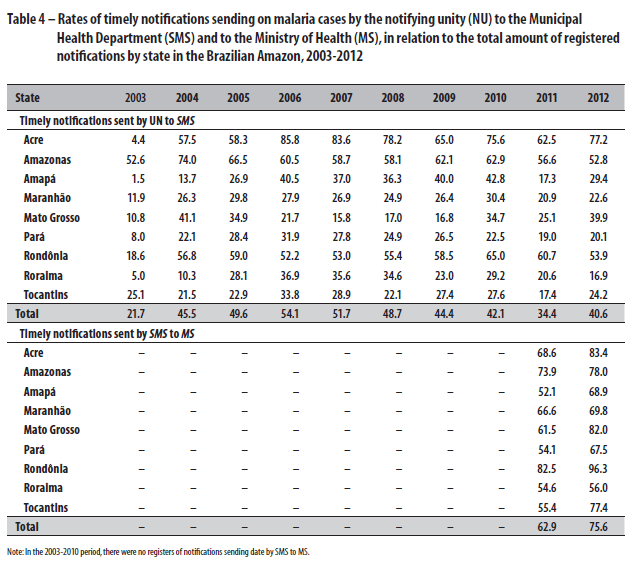
Regarding timely data sending by SMS to MS, 592,490 notifications were evaluated, corresponding to 99.1% of the total of new cases and recurrences in the last two years. In 2011, 62.9% of the notifications were timely sent (0-30 days) to the State Health Department (SES) and to MS, increasing to 75.6% in 2012. The average of timely notifications in the last two years was 69.3%, whilst the average was 20 days in 2011 and 13 days in 2012. In 2011, 75.0% of notifications were sent to SES and to MS in 47 days period, dropping to 30 days in 2012 (Figure 3). The state of Rondônia registered the best percentage in the timely data sending by SMS to MS, varying from 82.5% (2011) to 96.3% (2012). The state of Roraima registered the worst rates: 54.6°% (2011) and 56.0°% (2012) (Table 4).
Discussion
The results showed good completeness of malaria notifications. The timeliness in diagnosis and treatment was under the goal proposed by the Ministry of Health, of 24 hours starting from the first symptoms, whilst the timeliness on registering notifications in municipal and national levels was below recommended patterns by the World Health Organization.
An important aspect refers to the malaria notification by all NU in a unified form, whose data are directly transferred to MS without going through intermediary levels, allowing SMS, SES and MS to analyze it simultaneously, working in a cooperative way to control the disease. For over ten years, Sivep-Malaria overpassed the old routine of manual filling forms with data aggregated by hierarchic levels - NU, SMS, SES and MS -, a procedure that is very usual in countries (including African countries supported by WHO) where malaria notification is done by using various forms.11,20
We can notice an improvement in the forms filling when good completeness was reached at the end of 2012, to basically all fields. An exception was verified in the field 'occupation', with low completeness throughout the entire period. The satisfactory filling of this field, would allow the knowledge on the working activity of the malaria patient at the moment of the infection, which would help to subsidize control actions.22
The reasons that lead to low completeness might be related to the lack of compromise of the notifying agents,2 to other priorities of the authorities responsible for the control,3 to the non-acknowledgement of the relevance of the collected information12 and bureaucratic perception of the filling process, dissociating this action from the quality control.22
Regarding the 'ethnicity/skin color' field, it is important to highlight the raise in the completeness rate in the last two years of the period. This field is important to monitor and evaluate the ethnical/racial characteristics - of the indigenous and black populations especially -upon specific policies. In some surveillance systems, the completeness for this variable23 was bad.23
The categorization used for completeness (good, regular and low) is an adaptation of the methods used by other authors.3,6,7 WHO also considers completeness as good when it is higher than 90.0%.1 However, Santos et. al.22 used a different score to completeness: 0.0-25.0%, 25.1-50.0%, 50.1-75.0% e 75.1-100.0%; insufficient to measure good completeness, though, since it includes 25% of registers in the last interval. Although the fields have showed good completeness, up to 100.0% in some cases, the quality of the data could not be ensured due to the inconsistencies found in the age of some patients, surpassing 120 years old. Problems with atypical data also occurred with the fields 'typing date' and 'initial date of treatment', possibly due to the lack of reviewing in the data typing process.
The timely diagnosis and treatment suffered little variation, staying away from the Ministry of Health goals: 24 hours after the beginning of the first symptoms.21,24 Probably it is a goal to be reached in the long-term; however, the timeliness is an attribute to be measured according to the pattern adopted by each country,1 observing if the timely measure is coherent with the needs and goals of the existing surveillance system.8 On the other hand, it was clear that half of the patients, represented by the median, was diagnosed and treated in 2 days term, and most of them, equivalent to the third quartile, in 3 days. This is an improvement, considering the vast extension of the Brazilian Amazon and the hardships of transportation and access25 to health services in the region. Birkhead et. al. also used the median and the third quartile to measure the timeliness of the surveillance system,4 the same procedure adopted by Jajosky and Groseclose8 and Yoo et. al.10 However, it is recommended to revise the timely diagnosis and treatment concepts in MS publications,21,24 since the 24-hour term is not reachable in the current transmission levels of the disease.
The reduction of malaria, even with late timely diagnosis and treatment, can be related to the introduction of the treatment based on therapy combined with derivatives of artemisinin together with the use of mosquito nets impregnated with long duration insecticides,15 to the widening of the diagnosis and treating system, and to the decentralization process regarding health surveillance on a local level.
The difference between the number of evaluated cases to measure timely diagnosis and treatment is assigned to the lack of filling in the 'initial date of treatment' field, in some notifications where 'date of examination' was filled. Thus, the inconsistency in the 'date of examination' and 'initial date of treatment' fields, resulting in more than 365 days were excluded from the analysis according to procedures adopted in other studies.9,26
The delay in sending notifications by the notifying units to the municipal health departments, in 2003, is possibly attributed to the replacement of the old system of information (Sismal) for Sivep-Malaria, in which typed notifications in the former system had to be retyped in that year. In the following years, there was stability in sending notifications to SMS, although it always exceeded the timely term (7 days), with a worsening of the situation from 2010 on. This delay in the typing process can be a consequence of the lack of maintenance in the computers, or even a delay in the delivering of the notification forms by the NU. The weekly notifiable diseases register is adopted by other surveillance systems,8,9 including those for chronic diseases,27 being used both to measure the timeliness in data sending,28 and to have authorities adopt proper control measures. In countries where malaria is in elimination process, the registering of cases is performed in up to 24 hours.11 The ideal scenario is that at least 90.0% of notifications are registered according to the established time in each country.20
Regarding the opportunity in sending notifications by the Municipal Health Department to the Ministry of Health, only data from two years were available. However, a bigger proportion of notifications were timely sent to a national level, comparing with the proportion sent to a local level. Still, the proportion of notifications sent to MS was well under the ideal quantity of 90.0%. The monthly malaria data sending from a local level to a central level is adopted by countries like Iran,11 in agreement with WHO guidelines to countries of high and moderate transmission.20
The methods used in this study are not the only ones to evaluate the completeness and the timeliness of diseases notifications. There are many definitions of completeness to be used for different levels of measures, into a single database.29 In this case, timeliness can also be evaluated by cross-sectional studies.11 Good diseases surveillance, after all, will depend on the ability and the compromise of its managers.30 It is recommended to regulate the notifications registering term in local and central levels, as well as performing periodic evaluations of completeness, timeliness and other attributes of malaria surveillances system. Some actions are needed, such as revising the entry of fields with dates' formats.
The achievement of the ideal timeliness patterns cannot be declined, whether it is on diagnosis and treatment, whether it is on the notifications registering. Nonetheless, it is important to recognize the relevance of the data transmission model by Sivep-Malaria, through internet, in the direct data sending by the Municipal Health Department to the State Health Department and to the Ministry of Health, which might have helped to reduce cases of the disease in the evaluated period.
Authors' contributions
All authors contributed to the conception and design of the study, the analysis and interpretation of the results, drafting and relevant critical review of the intellectual content of the manuscript.
All authors approved the manuscript's final version declared to be responsible for all aspects of the work, ensuring its accuracy and integrity.
References
1. World Health Organization. Communicable disease surveillance and response systems: guide to monitoring and evaluating. Geneva: World Health Organization; 2006.
2. Doyle TJ, Glynn MK, Groseclose SL. Completeness of notifiable infectious disease reporting in the United States: an analytical literature review. Am J Epidemiol. 2002 May;155(9):866-74.
3. Oliveira MEP, Soares MRAL, Costa MCN, Mota ELA. Avaliação da completitude dos registros de febre tifoide notificados no Sinan pela Bahia. Epidemiol Serv Saude. 2009 set;18(3):219-26.
4. Birkhead G, Chorba TL, Root S, Klaucke DN, Gibbs NJ. Timeliness of National Reporting of communicable diseases: the experience of the national electronic telecommunications system for surveillance. Am J Public Health. 1991 Oct;81(10):1313-5.
5. Moreira CMM, Maciel ELN. Completude dos dados do Programa de Controle da Tuberculose no Sistema de Informação de Agravos de Notificação no Estado do Espírito Santo, Brasil: uma análise do período de 2001 a 2005. J Bras Pneumol. 2008 abr;34(4):225-9.
6. Macente LB, Zandonade E. Avaliação da completude do Sistema de Informação sobre Mortalidade por suicídio na região Sudeste, Brasil, no período de 1996 a 2007. J Bras Psiquiatr. 2010;59(3):173-81.
7. Barbuscia DM, Rodrigues-Júnior AL. Completude da informação nas declarações de nascido vivo e nas declarações de óbito neonatal precoce e fetal, da região de Ribeirão Preto, São Paulo, Brasil, 2000-2007. Cad Saude Publica. 2011 jun;27(6):1192-200.
8. Jajosky RA, Groseclose SL. Evaluation of reporting timeliness of public health surveillance systems for infectious diseases. BMC Public Health. 2004;4(29):1-9.
9. Vogt RL, Spittle R, Cronquist A, Patnaik JL. Evaluation of the timeliness and completeness of a web-based notifiable disease reporting system by a local health department. J Public Health Manag Pract. 2006 Nov-Dec;12(6):540-4.
10. Yoo HS, Park O, Park HK, Lee EG, Jeong EK, Lee JK, et al. Timeliness of national notifiable diseases surveillance system in Korea: a cross-sectional study. BMC Public Health. 2009 Mar;9(93):1-8.
11. Akbari H, Majdzadeh R, Foroushani AR, Raeisi A. Timeliness of Malaria Surveillance System in Iran. Iranian J Publ Health. 2013;4(1):39-47.
12. Zillmer JGV, Schwartz E, Muniz RM, Lima LM. Avaliação da completude das informações do Hiperdia em uma unidade básica do sul do Brasil. Rev Gauch Enferm. 2010;31(2):240-6.
13. Rodrigues RJ. Information systems: the key to evidence-based health practice. Bull World Health Organ. 2000;78(11):1344-51.
14. Lima CRA, Schramm JMA, Coeli CM, Silva MEM. Revisão das dimensões de qualidade dos dados e métodos aplicados na avaliação dos sistemas de informação em saúde. Cad Saude Publica. 2009 out;25(10):2095-109.
15. Ferreira JO, Lacerda MVG, Brasil P, Ladislau JLB, Tauil PL, Ribeiro CTD. Malaria in Brazil: an overview. Malar J. 2010 Apr;9(115):1-15.
16. Almeida LB, Barbosa MGV, Martinez-Espinosa FE. Malária em mulheres de idade de 10 a 49 anos, segundo o SIVEP - Malária, Manaus, Amazonas, 2003-2006. Rev Soc Bras Med Trop. 2010 maio-jun;43(3):304-8.
17. World Health Organization. WHO Global Malaria Programme: world malaria report 2012. Geneva: World Health Organization; 2012.
18. D'Souza BJ, Newman RD. Strengthening the policy setting process for global malaria control and elimination. Malar J. 2012 Jan;11(28):1-3.
19. Alonso PL, Brown G, Arevalo-Herrera M, Binka F, Chitnis C, Collins F, et al. A research agenda to underpin malaria eradication. PLoS Med. 2011 Jan;8(1):e1000406.
20. World Health Organization. Disease surveillance for malaria control: an operational manual. Geneva: World Health Organization; 2012.
21. Ministério da Saúde (BR). Secretaria de Vigilância em Saúde. Diretoria Técnica de Gestão. Guia para gestão local do controle da malária: diagnóstico e tratamento. Brasília: Ministério da Saúde; 2008. (Série B. Textos Básicos de Saúde)
22. Santos NP, Lírio M, Passos LAR, Dias JP, Kritski AL, Galvão-Castro B, et al. Completude das fichas de notificações de tuberculose em cinco capitais do Brasil com elevada incidência da doença. J Bras Pneumol. 2013 mar-abr;39(2):221-5.
23. Braz RM, Oliveira PTR, Reis AT, Machado NMS. Avaliação da completude da variável raça/cor nos sistemas nacionais de informação em saúde para aferição da equidade étnico-racial em indicadores do Índice de Desempenho do Sistema Único de Saúde. Saude Debate. 2013 out-dez;37(99):554-62.
24. Ministério da Saúde (BR). Secretaria de Vigilância em Saúde. Departamento de Vigilância Epidemiológica. Malária. In: Ministério da Saúde (BR). Secretaria de Vigilância em Saúde. Departamento de Vigilância Epidemiológica. Guia de vigilância epidemiológica. 7. ed. Brasília: Ministério da Saúde; 2010. p. 46.
25. Tauil PL. The prospect of eliminating malaria transmission in some regions of Brazil. Mem Inst Oswaldo Cruz. 2011 Aug;106(1):105-6.
26. Nicolay N, Garvey P, Delappe N, Cormican M, McKeown P. Completeness and timeliness of Salmonella notifications in Ireland in 2008: a cross sectional study. BMC Public Health. 2010 Sep;10(568):2-8.
27. Lo HY, Yang SL, Chou P, Chuang JH, Chiang CY. Completeness and timeliness of tuberculosis notification in Taiwan. BMC Public Health. 2011 Dec;11(915):2-9.
28. Sickbert-Bennett EE, Weber DJ, Poole C, MacDonald PDM, Maillard JM. Completeness of Communicable Disease Reporting, North Carolina, USA, 1995 — 1997 and 2000—2006. Emerg Infec Dis. 2011 Jan;17(1):23-9.
29. Weiskopf NG, Hripcsak G, Swaminathan S, Weng C. Defining and measuring completeness of electronic health records for secondary use. J Biomed Inform. 2013 Jun;46(5):830-6.
30. Keramarou M, Evans MR. Completeness of infectious disease notification in the United Kingdom: a systematic review. J Infect. 2012 Mar;64:555-64.
 Correspondence:
Correspondence:
Rui Moreira Braz -
Ministério da Saúde,
Secretaria de Vigilância em Saúde,
Departamento de Vigilância
das Doenças Transmissíveis,
Setor Comercial Sul, Quadra 4,
Bloco A, Edifício Principal, 4° andar,
Brasília-DF, Brasil. CEP: 70304-000
Email: rui.braz@saude.gov.br
Received on 12/02/2015
Approved on 09/11/2015











 texto en
texto en 
 Curriculum ScienTI
Curriculum ScienTI
